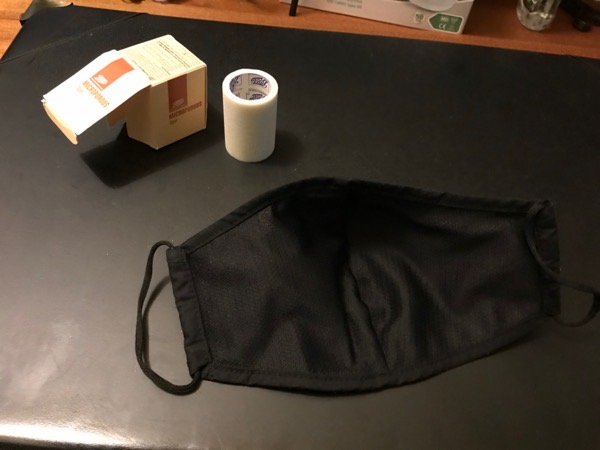glasses
-
Though see my later post. I think I’ll be doing it slowly from now on. ↩︎
Stop Your Glasses Steaming Up by Sticking the Top of Your Mask to Your Face Using Micropore Tape
The problem
If, like all sensible people, you wear a mask over your mouth and nose when you go out these days; and if, like me and millions of others, you wear glasses; then you will have experienced your breath causing your glasses to steam up.
The cause is a fundamental flaw in mask design: the mask fabric makes a straight line from our cheeks to the bridge of our noses, leaving a gap between face and mask seam. Most of our out-breaths are directed that way, just by taking the path of least resistance.
Some masks have a wire insert that lets you mould the top section around your nose. I find that improves things, but is still imperfect. There are always gaps.
The Bigger Problem
This means that the masks are not as effective as they should be for their primary purpose. All that warm, damp air that’s condensing on our glasses is also the air that might be carrying virus particles.
So while this solution helps with the steamed-up glasses problem, it also helps to make masks more effective, by ensuring that more of our potentially-poisonous breath goes through the fabric.
The Solution
It’s quite simple: apply a strip of micropore tape to the section of the mask that goes over the bridge of your nose, and seal it down well.

Micropore tape is normally used for fixing dressings on wounds, so it’s designed to stick to skin and come off with minimal fuss (though see below).
The roll we had when I thought of this is quite wide, so I’ve been folding a piece over and attaching it to the inside of the mask (at @FranChats’s suggestion).

As you can see, it’s not attached very tidily, but we’re not in this for the aesthetics.

And it’s not actually visible when the mask is on.
The New Problems: Removal, and Sensitivity
Taking the taped mask off is the worst part, in my experience. I’ve been doing it quickly: take off my glasses (otherwise they might go flying across the room); unhook the ear loops and take a firm grip of them; close my eyes; then tug sharply forward.1
It can make your eyes water, but honestly, for clear vision outside on these cold days, it’s worth it.
Removing it slowly might be better for some people. And the whole thing will not be for some. If you have very sensitive skin, or get a reaction to the adhesive, then this won’t be for you. But if you can take it, I highly recommend it.
Lastly, my pictures show a reusable mask, but it works for disposables too.